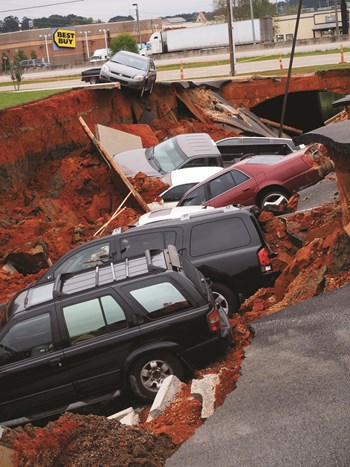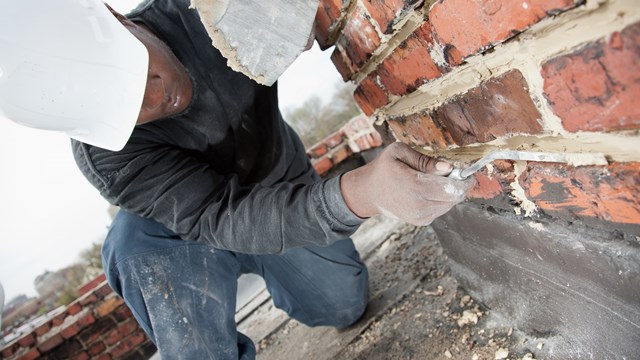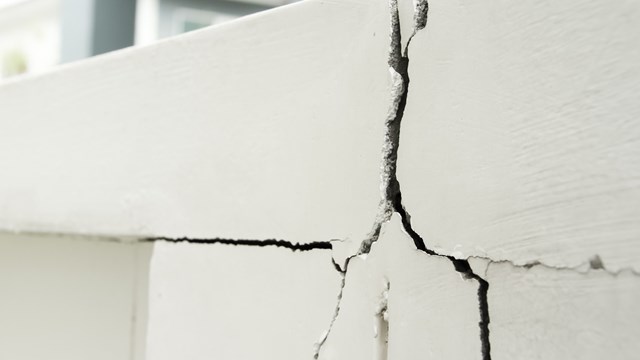
California has its landslides, the Midwest its tornadoes, and along with hurricanes, Florida has...sinkholes. They’re sort of like your own personal earthquake. There are many famous sinkholes, both large and small. The largest in the world is the Qattara Depression west of Cairo, Egypt; it measures 80 kilometers by 120 kilometers. The famous cenotes of Mexico can also be considered sinkholes; the water-filled underground caverns are sometimes open to the surface, and dot the landscape of the state of Quintana Roo on the Yucatan Peninsula.
Sinkholes can occur naturally (as in the case of the Mexican cenotes), or be man-made. They are not uncommon in Florida, as well as some other areas of the United States including New Jersey, Texas, Alabama, Missouri, Tennessee, Pennsylvania, and Kentucky. As a matter of fact, just few years ago, a sinkhole swallowed up a warehouse and showroom in Kentucky filled with classic cars.
The danger of sinkholes is proportional to their size and location, of course. If a sinkhole opens up in a remote rural area with few man-made structures and sparse population, its impact is negligible; if one should occur in the middle of Main Street in a densely populated urban area, the damage can be catastrophic – even tragic.
What is a Sinkhole?
According to the website conserve-energy-future.com, naturally occurring sinkholes “occur due to erosion or underground water. They start developing a long time before they actually appear. The ground beneath our feet is not as much of a solid structure as we think it is. It’s made up of dirt, along with many rocks and minerals. There is water continually seeping in between the mud, rocks, and minerals, [making] its way down to the ground water reservoirs. As this happens, the water slowly erodes the rocks and minerals. Sometimes the flow of water increases to a point when it washes away the underground structure of the land. And when the structure becomes too weak to support the surface of the earth, it collapses and opens up a hole. This is how sinkholes are formed.”
Those areas, which have bedrock consisting primarily of limestone and carbonate rock, also known as karst, are most susceptible to sinkhole formation. Florida sits upon one such geological zone. Florida’s sinkholes have swallowed up homes—and even part of a resort hotel building at Disney World.
Human activity can also contribute to the formation of sinkholes. “Activities like drilling, mining, construction, broken water or drain pipes, improperly compacted soil after excavation work, or even heavy traffic can result in small to large sinkholes,” according to the website. “Water from broken pipes can penetrate through mud and rocks and erode the ground underneath, causing sinkholes. Sometimes, heavy weight on soft soil can result in collapse...sinkholes can also form when the land surface is changed.”
Identifying the Problem
Jonathan McDonald is a specialist in sinkhole repair and remediation at Titan Foundation Repair Specialist LLC, based in Hernando County, Florida. Incidences of sinkholes have been documented though in the local print and electronic media, and McDonald says he has repaired sink holes in many condominium complexes nearby. He differentiates between various soil problems in Florida that are sometimes mistakenly referred to as sinkholes.
“Everyone wants to assume that everything is a sinkhole,” he says. “They get a slight depression, or a new crack and they’re sure it’s a sinkhole. We do get a lot of calls but they’re not necessarily sinkholes. You have to be able to see a sinkhole.” Homes moving, shifting and cracking can also be due to inadequate soil, loose sand or eroding limestone. “You need ground collapse,” says McDonald. “No ground collapse, no sinkhole.” He maintains that sinkhole formation has been exacerbated by “growing population, a dropping water table, and lack of regular rain followed by too much at once.”
Another problem that can cause similar symptoms is clay terrain. When clay becomes moist it expands, and when it dries it contracts, which can cause shifting, moving and cracking that may look similar to an impending sinkhole. Professional engineers or geologists and a battery of tests are required to determine what the exact cause of soil-based problems may be and whether it might be a sinkhole.
Repair and Remediation
There are two main methods of sinkhole repair and remediation: compact grouting and underpinning. Compact grouting is usually the first method tried, and can have two phases. McDonald explains: “We take three-inch steel pipes called casings, and we drill all the way down to limestone [around the structure], which can lie anywhere from 40 feet to 120 feet down from the surface. We drill three feet off the wall, every 10 feet around the house. The first pipe goes in at a 90-degree angle straight down. The next pipe will be angled at 15 degrees, because we want the grout to get under the house. It goes like that all the way around the house at alternating angles. Once we are done drilling, we come out with the pump and we pump in the grout, which is a type of concrete without the rocks. By the time [the grout] reaches the limestone, it’s way down under the house, thereby supporting it. Then we extract the pipes.”
The second phase can begin about 30 days later, if an engineer determines it is needed. “We repeat the process with 5/8-inch conduit pipe and chemical grout,” McDonald continues. “Chemical grout is a liquid that turns into a foam and firms up the ground under the house by stiffening it.”
The second method of sinkhole remediation is known as underpinning or foundation stabilization. “A one-foot by two-foot hole is dug every seven feet around the building,” says McDonald. “We then use an L-shaped bracket that fits into the hole and under the foundation. We have three-inch casing pipe that we then push hydraulically all the way down till we hit limestone. We are looking for a lift on the foundation, or 3,400 pounds of pressure per square-inch. We use these methods for every type of structure; commercial or residential, including both multifamily buildings and single family homes.”
Prevention and Insurance
Given the multiple factors that can contribute to the formation of a sinkhole, is it possible to take any type of preventive measures to avoid them? Maybe – but in some cases, ‘prevention’ means avoiding building in some areas entirely, or undertaking serious pre-construction stabilization of the underlying ground. “Before you build in a mining or karst area, you should do some testing and address the condition ahead of time,” says one engineer. If you’re dealing with karst geology, “You use some kind of filling, flowable fill, or concrete grout to fill the void. With mining sites, it’s much more difficult because of how deep the mines can go. Some go down over 1,000 feet. So we try to fill the upper 30 or 40 feet. The difficulty is, how do you get the fill to stay at the top [as opposed to trickling down through the substrate, as water does]? It’s complicated engineering.”
When preventive steps aren’t taken – either because of the expense, or because it simply wasn’t known that a piece of land was sinkhole-prone before construction was carried out – there is insurance coverage to protect property owners and administrators from at least some of the costs associated with collapsing earth. According to TrustedChoice.com, “Many homeowner and business insurance policies offer special endorsements for sinkhole coverage. Without this additional coverage, sinkhole damage is frequently not covered [by general liability policies]. If your home or business is destroyed by a sinkhole and you do not have a sinkhole insurance policy, you may receive no compensation for your losses. You can get coverage for your vehicle simply by including comprehensive coverage with your car or truck insurance policy. This coverage will provide you with compensation for loss or damage caused by sinkholes as well as other common occurrences such as fire, inclement weather, falling objects and theft.”
Sinkhole insurance provides compensation for damages to your business or home, outlying property and personal belongings kept inside the building if they are damaged as the result of a sinkhole on your property. This insurance will also cover necessary preventive measures, such as structural bracing, to keep an impending sinkhole from causing severe damage.
According to a representative for TrustedChoice, the cost of sinkhole coverage can range between $30 and $100 per month, translating to $360 to $1,200 per year. This appears to be a small price to pay, compared to the possible cost of repairing or remediating sinkhole damage, which as we’ve seen can run into the tens or hundreds of thousands of dollars.
“You don’t have to be an engineer to look at the news or look online to know that Florida has a soil problem. We don’t have to call it a sinkhole,” says McDonald. “Let’s say it’s a soil problem. We’ve got inadequate soil in Florida – and eventually over time, no matter what, you’re going to have a problem with your house. One of the smart things would be to offer packages to homeowners to shore up the soil pre-construction. They can wrap up the cost of the prevention in their loan, and over the next 30 years, they’ll never see it. They never have to worry about this problem again and they wouldn’t need to get sinkhole coverage, which can be very expensive.”
Legal Provisions
On May 17, 2011, the Florida legislature passed a new sinkhole law which significantly changed the statute of limitations for filing a claim, rules covering Public Adjuster and the definition of structural damage. For more information click on this link, http://www.sinkholeattorney.com/legislative-update.htm. So, watch those cracks and shifts, and consult a professional, because a sinkhole can get you into deep trouble!
A.J. Sidransky is a staff writer and reporter for The South Florida Cooperator.






Leave a Comment